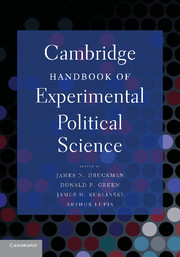Book contents
- Frontmatter
- Contents
- List of Tables
- List of Figures
- Contributors
- Acknowledgments
- INTRODUCTION
- PART I DESIGNING EXPERIMENTS
- PART II THE DEVELOPMENT OF EXPERIMENTS IN POLITICAL SCIENCE
- PART III DECISION MAKING
- PART IV VOTE CHOICE, CANDIDATE EVALUATIONS, AND TURNOUT
- PART V INTERPERSONAL RELATIONS
- PART VI IDENTITY, ETHNICITY, AND POLITICS
- PART VII INSTITUTIONS AND BEHAVIOR
- 24 Experimental Contributions to Collective Action Theory
- 25 Legislative Voting and Cycling
- 26 Electoral Systems and Strategic Voting (Laboratory Election Experiments)
- 27 Experimental Research on Democracy and Development
- PART VIII ELITE BARGAINING
- PART IX ADVANCED EXPERIMENTAL METHODS
- AFTERWORD
- Name Index
- Subject Index
- References
25 - Legislative Voting and Cycling
Published online by Cambridge University Press: 05 June 2012
- Frontmatter
- Contents
- List of Tables
- List of Figures
- Contributors
- Acknowledgments
- INTRODUCTION
- PART I DESIGNING EXPERIMENTS
- PART II THE DEVELOPMENT OF EXPERIMENTS IN POLITICAL SCIENCE
- PART III DECISION MAKING
- PART IV VOTE CHOICE, CANDIDATE EVALUATIONS, AND TURNOUT
- PART V INTERPERSONAL RELATIONS
- PART VI IDENTITY, ETHNICITY, AND POLITICS
- PART VII INSTITUTIONS AND BEHAVIOR
- 24 Experimental Contributions to Collective Action Theory
- 25 Legislative Voting and Cycling
- 26 Electoral Systems and Strategic Voting (Laboratory Election Experiments)
- 27 Experimental Research on Democracy and Development
- PART VIII ELITE BARGAINING
- PART IX ADVANCED EXPERIMENTAL METHODS
- AFTERWORD
- Name Index
- Subject Index
- References
Summary
Discoveries regarding the scope and meaning of majority rule instability have informed debate about the most fundamental questions concerning the viability of democracy. Are popular majorities the means of serving the public interest or a manifestation of the absence of equilibrium (Riker 1982)? Should majority rule legislatures be suspect or even avoided in favor of court decisions and bureaucratic delegation? Are the machinations of agenda setters the true source of what we take to be the legislative expression of majority rule? Are rules themselves subject to the vagaries of shifting majority coalitions (McKelvey and Ordeshook 1984)?
These and other questions were raised as a result of explorations in Arrovian social choice theory, which visualized group decisions as being the product of individual preferences and group decision rules such as majority rule. The biggest challenge to the research agenda was majority rule instability. In general, majority rule may not be able to produce a majority rule winner (an outcome that beats every other in a two-way vote). Rather, every possible outcome could lose to something preferred by some majority coalition. McKelvey (1976) showed that the potential for instability was profound, not epiphenomenal. A population of voters with known preferences might easily choose any outcome, or different outcomes at different times. If this were true, then how could scholars predict the outcome of a seemingly arbitrary and unconstrained majority rule institution, even with perfect knowledge of preferences? Was literally anything possible?
- Type
- Chapter
- Information
- Cambridge Handbook of Experimental Political Science , pp. 353 - 368Publisher: Cambridge University PressPrint publication year: 2011
References
- 2
- Cited by



